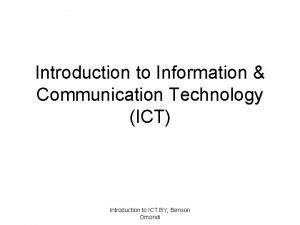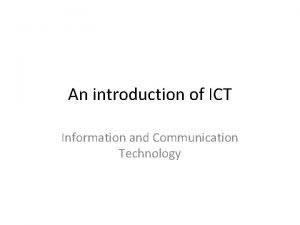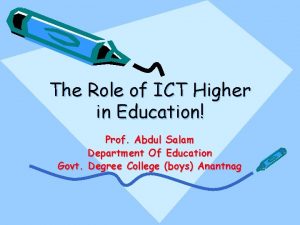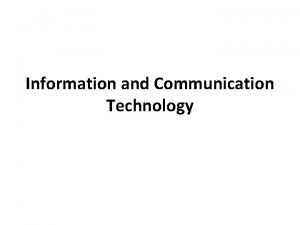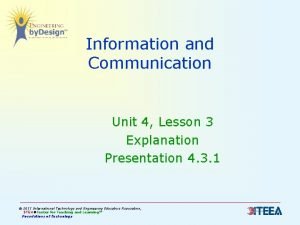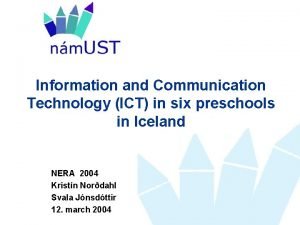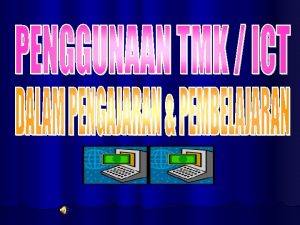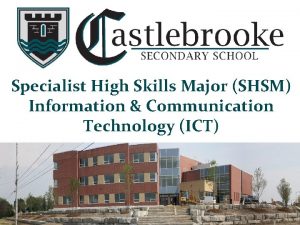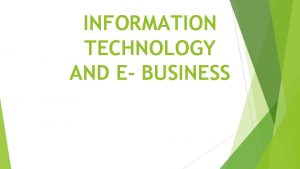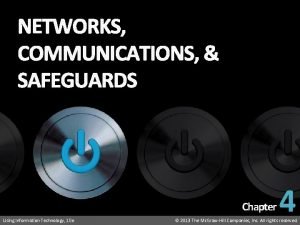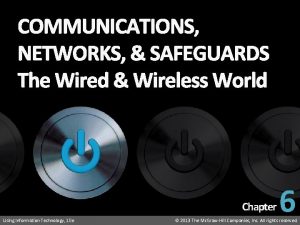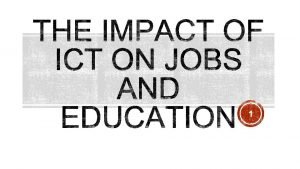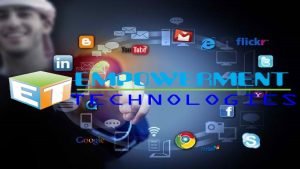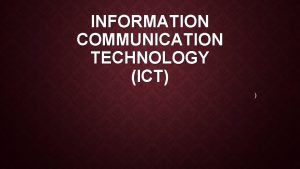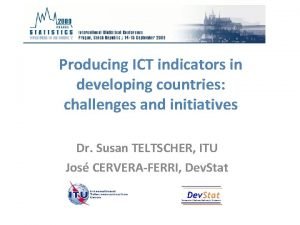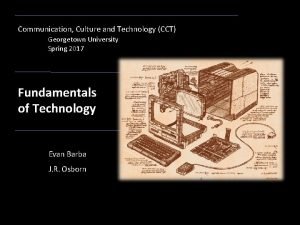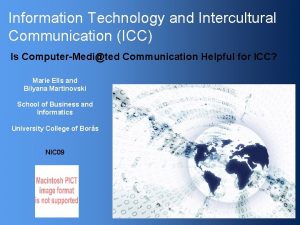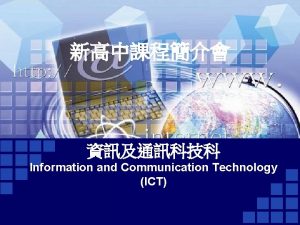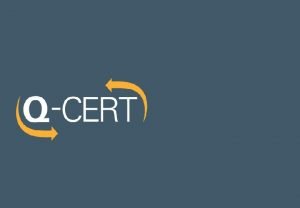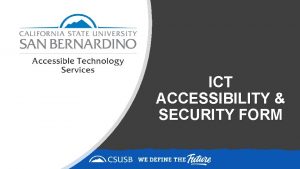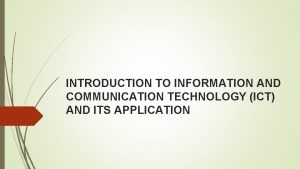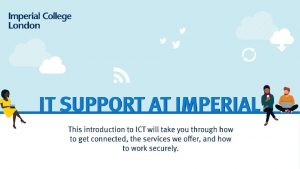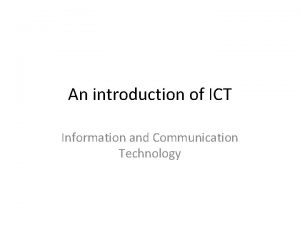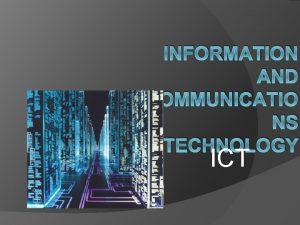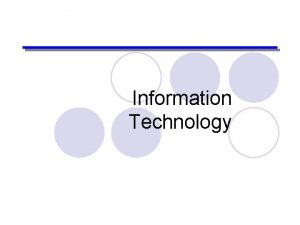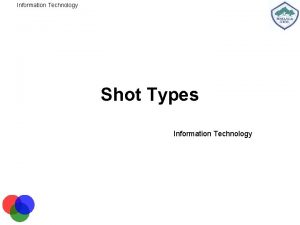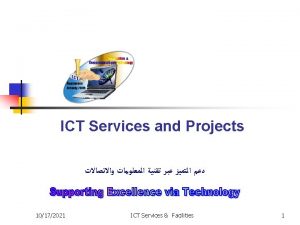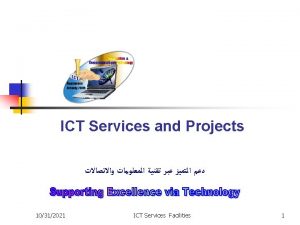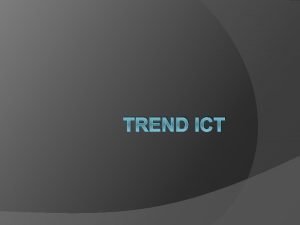An introduction of ICT Information and Communication Technology


















- Slides: 18

An introduction of ICT Information and Communication Technology

Parts of a computer A computer is really a system of many parts working together. The physical parts, which you can see and touch, are collectively called hardware. (Software, on the other hand, refers to the instructions, or programs, that tell the hardware what to do. ) The illustration below shows the most common hardware in a desktop computer system. Your system may look a little different, but it probably has most of these parts. A laptop computer has similar parts but combines them into a single notebook-sized package.

System unit The system unit is the core of a computer system. Usually it's a rectangular box placed on or underneath your desk. Inside this box are many electronic components that process information. The most important of these components is the central processing unit (CPU), or microprocessor, which acts as the "brain" of your computer. Another component is random access memory (RAM), which temporarily stores information that the CPU uses while the computer is on. The information stored in RAM is erased when the computer is turned off. Almost every other part of your computer connects to the system unit using cables. The cables plug into specific ports(openings), typically on the back of the system unit. Hardware that is not part of the system unit is sometimes called a peripheral device or device.

Storage Your computer has one or more disk drives—devices that store information on a metal or plastic disk. The disk preserves the information even when your computer is turned off. Hard disk drive Your computer's hard disk drive stores information on a hard disk, a rigid platter or stack of platters with a magnetic surface. Because hard disks can hold massive amounts of information, they usually serve as your computer's primary means of storage, holding almost all of your programs and files. The hard disk drive is normally located inside the system unit.

CD and DVD drives Nearly all computers today come equipped with a CD or DVD drive, usually located on the front of the system unit. CD drives use lasers to read (retrieve) data from a CD, and many CD drives can also write (record) data onto CDs. If you have a recordable disk drive, you can store copies of your files on blank CDs. You can also use a CD drive to play music CDs on your computer.

Mouse A mouse is a small device used to point to and select items on your computer screen. Although mice come in many shapes, the typical mouse does look a bit like an actual mouse. It's small, oblong, and connected to the system unit by a long wire that resembles a tail. Some newer mice are wireless.

Mouse usually has two buttons: a primary button (usually the left button) and a secondary button. Many mice also have a wheel between the two buttons, which allows you to scroll smoothly through screens of information. When you move the mouse with your hand, a pointer on your screen moves in the same direction. (The pointer's appearance might change depending on where it's positioned on your screen. ) When you want to select an item, you point to the item and then click (press and release) the primary button. Pointing and clicking with your mouse is the main way to interact with your computer. For more information

Keyboard • A keyboard is used mainly for typing text into your computer. Like the keyboard on a typewriter, it has keys for letters and numbers, but it also has special keys: – The function keys, found on the top row, perform different functions depending on where they are used. – The numeric keypad, located on the right side of most keyboards, allows you to enter numbers quickly. – The navigation keys, such as the arrow keys, allow you to move your position within a document or webpage.

Monitor • A monitor displays information in visual form, using text and graphics. The portion of the monitor that displays the information is called the screen. Like a television screen, a computer screen can show still or moving pictures. – There are two basic types of monitors: CRT (cathode ray tube) monitors and LCD (liquid crystal display) monitors. Both types produce sharp images, but LCD monitors have the advantage of being much thinner and lighter. CRT monitors, however, are generally more affordable. LCD monitor (left); CRT monitor (right)

Printer A printer transfers data from a computer onto paper. You don't need a printer to use your computer, but having one allows you to print e‑mail, cards, invitations, announcements, and other materials. Many people also like being able to print their own photos at home. – The two main types of printers are inkjet printers and laser printers. Inkjet printers are the most popular printers for the home. They can print in black and white or in full color and can produce high-quality photographs when used with special paper. Laser printers are faster and generally better able to handle heavy use. Inkjet printer (left); laser printer (right)

Speakers • Speakers are used to play sound. They may be built into the system unit or connected with cables. Speakers allow you to listen to music and hear sound effects from your computer

Modem • To connect your computer to the Internet, you need a modem. A modem is a device that sends and receives computer information over a telephone line or high-speed cable. Modems are sometimes built into the system unit, but higher-speed modems are usually separate components.

How pc components function together • Motherboard CPU Memory Monitor Hard disk DVD drives Keyboard Mouse Cards Case Power unit

• What is motherboard? • When you open your computer for the first time, you will soon get a flat board screwed on the inside part of the case. That is what we call computer motherboard - the most important of all other parts. What is CPU? The Central Processing Unit (CPU) is an electronic component that interprets and carries out the instructions of any application that run on a computer. It is a place where all the computing is done. How do you measure your computer processing speed? The efficiency of computer processor is measured in using the machine cycle and clock speed. Machine cycle = instruction + execution. Clock speed = a series of pulse produced by the CPU at predetermined time. Machine cycle is affected by the CPU clock speed. The shorter the gap between the pulses, the faster the processing speed would be. The machine cycle is measured in nanoseconds (one-billionth of one second) and pico seconds (one-trillionth of one second). Clock speed is measured in megahertz, MHz (millions of cycles per second) or gigahertz, GHz (billions of cycles per second). The clock speed determines the speed at which the processor executes instructions. A computer with 3. 4 GHz microprocessor means it operates at a speed of 3. 4 billion cycles per second. This tells us a 3. 4 GHz processor is faster than 3. 0 GHz processor. However, the speed of the processor doesn't necessarily mean speed of a computer. It also depends on motherboard speed.

• • What is computer memory (RAM)? Memory is a temporary workspace for CPU (central processing unit). Memory holds temporary instructions and data needed by CPU to complete tasks. This is because the CPU quickly accesses those instructions from memory than hard disk, make the processing fast. Function and types of Computer cards are devices which are used to connect peripheral components. They are a printed circuit board used to accomplish a specific task. These types of cards can be connected to a computer in two ways: • Using the PCI slots on a motherboard This is a typical interface used mostly. If the on-board card fails to work, it is possible to plug a new card on the PCI slot and continue your work. This is one of the advantages of having PCI slots on a motherboard. • Built-in on a motherboard Current computer already have all the main cards integrated with the main board, no need to buy additional cards. Unless for better performance specially if you are in video gaming and graphica What is a computer case? Computer case is used to house all the components of computer except monitor, keyboard and mouse. It is designed to hold the parts so that each component easily connects to the main board. There are different kinds of cases available on the market which differs in size and shape. Like we do have different form factors of motherboard and power supply, computer case also have its own shape and dimension. Not all cases are made for every type of motherboard and power supply we find on the market.

What is computer software? • What is computer software? Every day in one way or another, we use computer to perform our tasks both at the office and home. It is possible to say that today’s world is computer driven world, where every task is done through computer. And without the usage of software, computer does nothing. • Computer software controls how a computer should execute a particular type of task. • Generally, computer systems are categorized into two major parts: Hardware and Software. The major functions computer system software - Manages computer processing activities - Managing files - Handle computer memory - Serves as an interface between computer user and hardware - Providing access to system resources - Facilitate the overall activities of each programs installed on it - Providing an interface for peripheral devices and network access - Allows user to run application programs

Example of Operating System Software • Operating systems can be categorized further into two categories: – Personal computer OS and – Enterprise/Workgroup OS. Some of the popular Personal computer OSs include: • - Microsoft products (research shows 80% of computers in the world installed with Microsoft OSs) • Windows 95, Windows ME, Windows 2000, Windows XP, Windows Vista, Windows 7 and Windows Mobile • - Apple Computer System programs • Mac OS and Mac OS X • - Linux – It is developed by Linus Torvalds, a student in Finland, in 1991. Linux is an Open-source operating system, means the source code is available freely. – - UNIX – - Solaris – - Red Hat Linux

• The following are the popular enterprise and workgroup operating systems: • - Windows Advanced Server • - Windows Server 2000, 2003 and 2008 • - UNIX - Red Hat Linux • - MPE/i. X are servers software • – designed for HP Computers Application Software is a type of program which assists a user to execute a specific task on a computer. It helps a user to solve particular problems. Application programs use system resources and hardware through System programs. Some of the tasks of Application programs - Word processors, Spreadsheet, presentation (Microsoft Office Suite) - Database manipulation - Accounting and Financial recording programs - Graphics (Adobe Suite) programs - Engineering Applications (Auto. CAD, Archi. CAD, In. Roads, Staad. Pro, SAP, Eagle point etc. . ) for designing roads, building and bridges - Desktop publishing (Adobe Indesign, Pagemaker) - Games
 An act of transmitting messages
An act of transmitting messages Introduction to information and communication technology
Introduction to information and communication technology Conclusion
Conclusion Information and communication technology capability meaning
Information and communication technology capability meaning Ictmeaning
Ictmeaning Components of information and communication technology
Components of information and communication technology Definition information and communication technology
Definition information and communication technology Apa itu technology
Apa itu technology Shsm information communication technology
Shsm information communication technology Discuss about information technology and e-business
Discuss about information technology and e-business Introduction to information technology: your digital world
Introduction to information technology: your digital world Introduction to information technology: your digital world
Introduction to information technology: your digital world What is information
What is information Trends in ict assistive media examples
Trends in ict assistive media examples Ict stands for
Ict stands for Introduction of ict
Introduction of ict Communication technology meaning
Communication technology meaning Georgetown university communication culture and technology
Georgetown university communication culture and technology Technology and intercultural communication
Technology and intercultural communication
